The first thing I learned about the ex-millionaire castaway is that he loves to talk politics.

For the first 30 minutes of our recent three-hour conversation — made possible by satellite phone — I was flooded with meandering ruminations on Ukraine, Elon Musk, and the global economy. I was speaking to a man who had many opinions, but nobody to share them with.
That’s because David Glasheen, 78, has, by his own choice, been marooned on a remote island in northern Australia for 25 years.
Before Glasheen moved to this island, he was a successful entrepreneur worth nearly $30m on paper. He says he had two yachts, owned multiple waterfront properties, and caroused with titans of Australian commerce.
Today, he lives alone for long stretches at a time, seldomly returning to the mainland. He sports a sea-swept white beard and forages for oysters barefoot and shirtless. His only permanent companions are two mannequins named Miranda and Phyllis.
What compelled a one-time multimillionaire to trade in luxury and comfort for a life of seclusion?
From riches to rags
Forty years ago, David Glasheen was at the peak of a successful career in business.
The son of a lawyer and a dietician, he grew up on the Sydney Harbor and enjoyed an idyllic childhood. After notching degrees in commerce and management, he went on to work in the tobacco industry, then launched an ice cream brand for an Australian dairy manufacturer.
“After some years doing that,” he said, “I was itching to ditch the corporate shackles and do my own thing.”
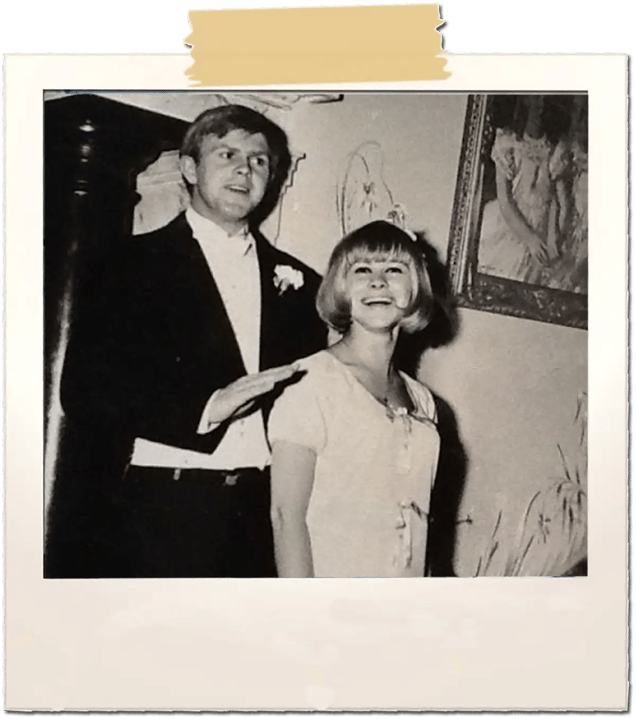
Glasheen in his late 20s, with his then-wife (David Glasheen)
Glasheen was approached by a friend with a map that supposedly charted the location of a gold mine in Papua New Guinea. Selling the promise of riches, he raised $2m in capital and launched a mining exploration firm that later went public on the Australian Securities Exchange.
In the speculative boom of the 1980s, the shares in his newly formed company soared from 25 cents to $1.40.
On paper, Glasheen’s net worth ballooned into the millions.
By conventional measures, life was a dream: He was happily married with two daughters, owned multiple beachfront properties in Sydney, and went on skiing excursions at lavish American resorts.
But the high times wouldn’t last.
The crash
On Monday, Oct. 19, 1987, Wall Street crashed, wiping out more than $500B in capital in 24 hours. The next day, the Australian market followed suit — and over two days, many stocks dipped 40%.
Glasheen faced a serious predicament: Nearly his entire net worth was tied up in his shares.
As the chairman, he couldn’t pull out for fear of stoking even more panic among investors. High-risk investments like his mining firm were hit especially hard. He sat helplessly, watching his holdings sink in real-time, from $1.40 to $0.28, then eventually $0.02.
And things got worse.
Glasheen had been borrowing heavily on his properties to purchase more stock. “I’d put all of my chips in one basket,” he says, “and I was basically going fishing with others’ bait.”
The banks came knocking. And by 1991, he was evicted from his home, rendering him “homeless and penniless.”
The financial ruin decimated his marriage and fractured his family life. He started drinking. He grew irritable and distant.
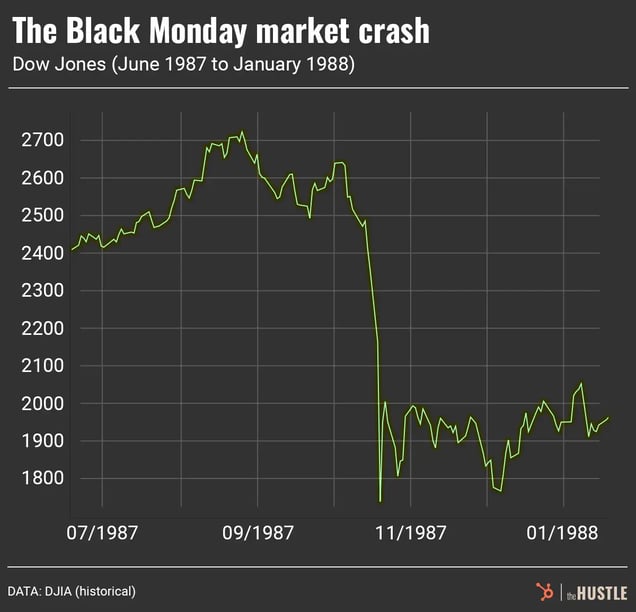
Zachary Crockett / The Hustle
Glasheen went through a period of “intense turmoil.” For several years, he slept on friends’ couches while cobbling together cash by brokering relationships in the mining sector.
Eventually, he moved in with a beauty salon owner named Denika and attempted to settle back into domestic life.
Soon, he found himself yearning for some kind of escape.
Restoration Island
As a child, Glasheen had been an avid beachcomber. He’d spent his days collecting shells, catching flathead and bream, and dozing off in the sand under the stars.
So when an old-friend-turned-real-estate-agent told him about a remote island for lease, it sparked a light buried in his soul.
The land in question — Maʼalpiku Island National Park, or Restoration Island — was perched near the northern tip of Queensland, a good 2k miles from Sydney. It could only be accessed via several flights in twin-propeller planes, a 25-mile drive over bumpy dirt roads, and a 15-minute boat ride from the mainland.
Glasheen first visited “Resto” in 1993, and he was at once enchanted and distraught.
It was like an island out of a cartoon of paradise: white sands, palm trees, turquoise waters. It was also in a state of disrepair, strewn with trash and crumbling structures.
A consortium of businessmen had purchased a 30-year lease on the island in 1979 for $156k. In 1989, they’d negotiated an extension to 50 years, in exchange for giving back the two-thirds of the island that was uninhabitable to the nearby native Kuuku Ya’u people.
Now, these businessmen were looking to sell their one-third stake for the sum of $1.2m.
Glasheen didn’t have that kind of cash. But he was able to convince a few investor friends to put up enough to sublease the habitable third of Resto. Eventually, he secured one of eight shares in the island, under the agreement that he and his partners would develop the land.
Glasheen’s abode, Restoration Island, sits at the northern tip of Australia, not far from Papua New Guinea (Google Maps)
His fellow shareholders had grandiose plans for Resto: a 60-bed eco-resort for vacationing Aussies. But the Kuuku Ya’u people — and Glasheen — found the idea to be repulsive. Eventually, the project got ensnared in a title claim and was halted.
For several years, the island sat empty and neglected.
Then, in 1997, Glasheen packed a small suitcase with a few shirts, some board shorts, a torch, and toiletries, and decided to move there on his own.
He never truly came back.
Life on the island
When he first moved to Resto, Glasheen was 60 pounds overweight and battling alcoholism. Now nearly 80, he says he’s in the best shape of his life.
With aqua eyes, a flowing white beard, and sun-dappled skin, he looks a bit like Santa Claus on vacation.
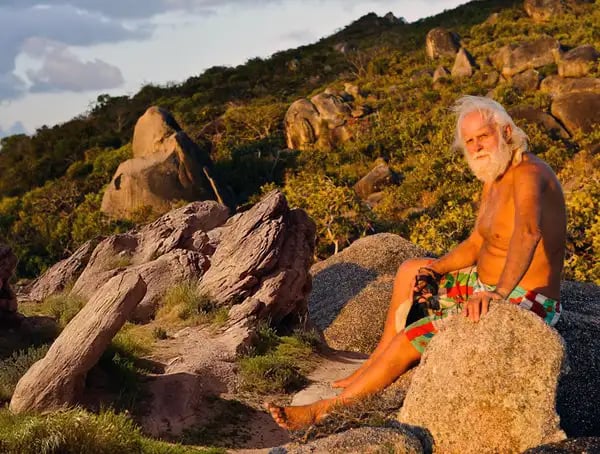
Glasheen perched atop Restoration Island several years ago (David Glasheen)
In the city, Glasheen was never a handy person. On Resto, he’s become a resourceful survivalist.
With the help of friends and visitors, he’s built a number of structures, including a main residence with a beached log foundation, a sheet metal roof, crates for seats, and a sleeping quarters that looks out over the sea. He stuffs his pillow with cottonlike fluff from local kapok trees .
“On the island, even the smallest thing has a purpose,” says Glasheen. “Nothing goes to waste.”
Glasheen doesn’t consider himself to be retired; there is a lot to be done on an island. Once littered with trash, Resto’s shores are now tidy and kempt. He’s planted hundreds of trees — palms, poinciana, casuarina — and takes pride in trimming his home’s small patches of grass.
He does enjoy several modern amenities:
- A makeshift shower utilizes water sourced from four storage tanks and pipes that are heated by bamboo chips.
- A gas-powered freezer, powered by a generator, houses perishables.
- A satellite dish provides phone service and internet — though the latter is extremely slow.
- A small boat, which he uses to venture back to civilization for supplies several times per year.
There are more than 30 sources of food on the island. Glasheen forages for beach almonds, wongai plums, and bush cherries. He gathers fresh oysters for lunch, and catches fish for dinner.
He also brews his own beer, which he occasionally barters with passing fishermen in exchange for crayfish and prawns. He takes pride in these negotiations, and says he once traded 12 bottles of grog (~$10 worth) for $400 worth of fish.
“It’s basic supply and demand,” says the ex-businessman. “If the fishos look tired and parched, I might charge a little more.”
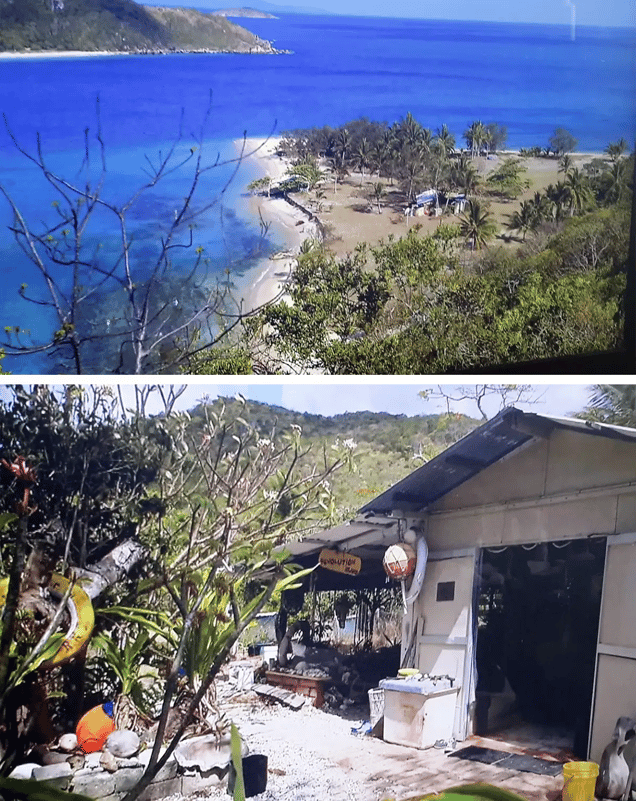
Glasheen lives in a hut he constructed on the island (screenshots via ICI Explora)
“People romance the idea of paradise,” Glasheen says. But on the island, there are myriad things that can go wrong.
On land, he has to contend with mosquitoes, acid-spraying ants, and deadly snakes and spiders. He’s kept a succession of dogs on the island, two of which have been killed by venomous bites.
The water is infested with sharks and saltwater crocodiles, which often watch him as he goes about his day. “If you get chased by a croc,” he says, “it’s best to run in zigzags to throw them off.”
Glasheen’s routine is dictated by the weather.
During the wet season (November through April), frequent torrential downpours threaten his life. He’s survived at least three cyclones, the most recent of which (Trevor, in 2019) left the island in shambles.
Living this lifestyle has completely rejiggered his decision-making process.
“As a corporate bloke, you plan out every little decision months in advance,” he says. “On the island, you don’t have time to react. You must act quickly.”
Once tethered to schedules, Glasheen now only looks at the clock when he needs to know the times of the tides.
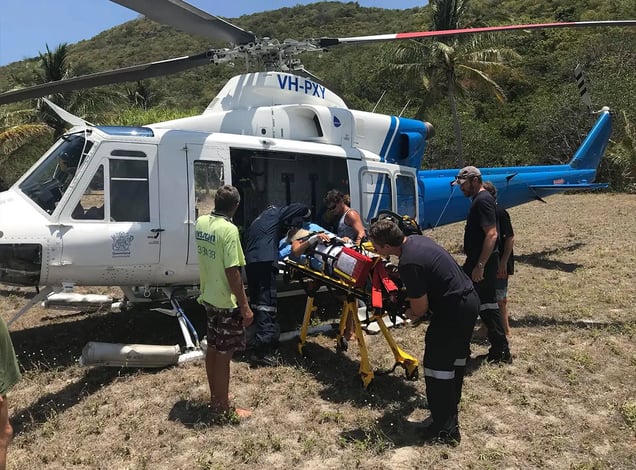
Several years ago, Glasheen fell, broke his hip, and had to get medevaced off the island (David Glasheen)
On occasion, Glasheen will host curious visitors and WWOOFers (roving farm volunteers).
Some, like the Austrian tourist who demanded 10 showers a day, had trouble adjusting to the castaway lifestyle and irked Glasheen. Others, like the marketing director who dropped everything to become a holistic healer, inspired him.
“I’ve met lots of young people who don’t know what they want in life,” he says. “They’re under pressure — racing around in circles and going nowhere — and they want some sort of dramatic change.”
He’s also enjoyed some famous company over the years:
- Fred Turner, the onetime CEO of McDonald’s, visited several times with a cadre of executives for bonding retreats. (Glasheen claims to have advised him on healthier menu options.)
- Russell Crowe stopped by on his honeymoon in 2003, while on a yacht tour of the Great Barrier Reef. (“He asked me for a picture, but I turned him down,” says Glasheen.)
Though Glasheen insists that he’s “secluded, not isolated,” he also admits that companionship has been a big sacrifice.
In the early years, his one-time partner Denika tried to share the island life with him. They had a son together, and she eventually left with the child. At the behest of a WOOFer, he tried online dating sites like Zoosk and PlentyOfFish. He didn’t get many bites.
He jokes that his “girlfriends” are two mannequins: Phyllis and Miranda. The latter, his main squeeze, was sourced from a junkyard for $10 and named after a character in Shakespeare’s “The Tempest.”
They reside in his main residence, but the relationship is strictly platonic (“I do not have sexual relations with them,” he clarified in a book he co-wrote in 2019).
The most painful toll of island life, though, has been a fractured relationship with family. His son, now a 22-year-old DJ, seldom visits. A decade ago, one of his daughters took her life. It nearly destroyed him.
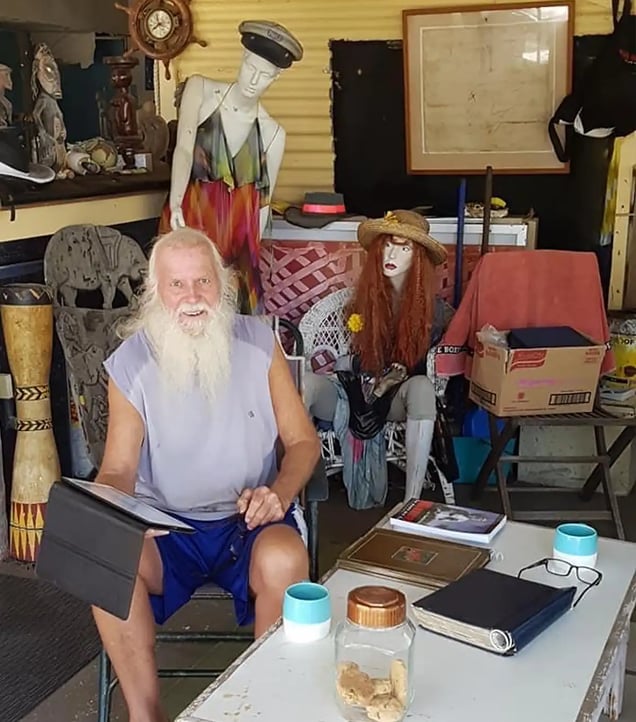
Glasheen in his home, with Miranda and Phyllis looking on (David Glasheen)
For the past 25 years, Glasheen has essentially been squatting on this little contested piece of paradise.
In 2012, the island’s majority leaseholder, a fellow Aussie businessman, took Glasheen to court and won the right to evict him. But Glasheen, who has since gained the support of local police and the trust of the nearby native Kuuku Ya’u people, has managed to stave off forceful removal.
For years, he has tried to buy out the leaseholder so that he can build a healing retreat and gift the lease back to the Kuuku Ya’u. He reckons it’ll take somewhere between $500k and $1m to make that happen.
During his time on the island, he’s come to see money as a “false god.” But he’s taken on several side hustles in a bid to raise capital.
He’s hosted corporate retreats at $1k per head and offered real-life castaway experiences to men in mid-life crises. More recently, he’s dabbled in cryptocurrency and launched a GoFundMe campaign.
But like the beached wood that peppers Resto’s shores, the cash has dried up. And for now, his tenancy situation is a cyclone of uncertainty.
“Legally,” he says, “I’m a trespasser.”
A castaway by choice
Glasheen isn’t the only person to voluntarily maroon on an island:
- Masafumi Nagasaki, dubbed “the naked hermit,” lived alone for 29 years on a remote island east of Taiwan. In 2018, at the age of 82, Japanese authorities forced him to move back to the mainland due to health issues.
- Gerald Kingsland, a British journalist, and his companion Lucy Irvine lived on an island near Papua New Guinea in 1981 with few provisions and no water supply. They had to be rescued by local Badu islanders.
- Edward Banfield, an author and naturalist, moved to a secluded Australian island with his wife in 1900. They built a home and lived there for 23 years.
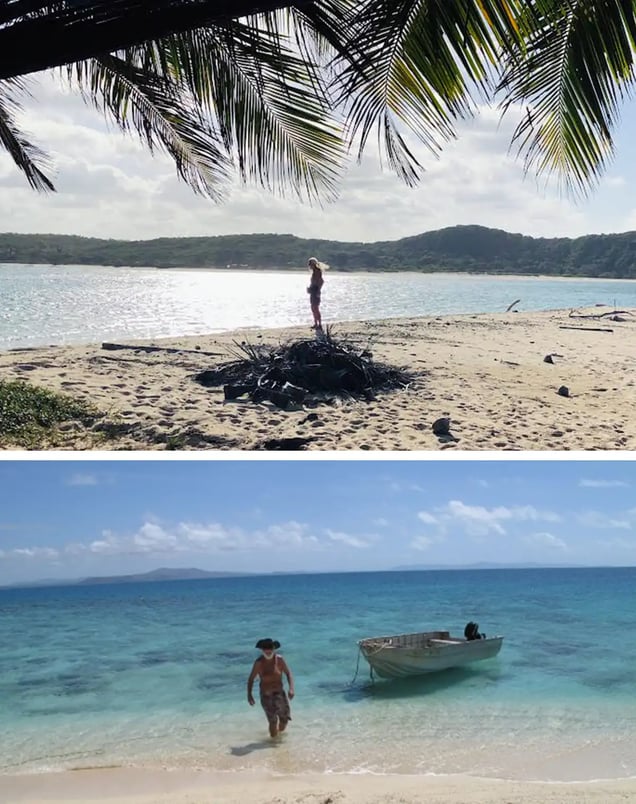
Glasheen surveying the seas (Martine Bramwell / David Glasheen)
There’s a name for this phenomenon: Inverted Crusoesim.
The term is a reference to Daniel Defoe’s famous 1719 novel, Robinson Crusoe, which chronicles the fictional tale of a man who woke up from a shipwreck on a remote island, where he remained for two decades. (Crusoe’s plight was unintentional, hence the “inverted” part.)
Modern society has long been enchanted by tales of island isolation.
This obsession has spawned a whole Robinsonade genre (“Cast Away,” “Survivor,” “LOST”), which grapples with the themes of natural rejuvenation, escapism, self-reliance, and rugged individualism.
Most fictional castaways not only accept their fate, but also learn to bask in it: What begins as a prison becomes a sanctuary.
For Glasheen, the prison is now the world outside of the island.
The things he once valued — money, prestige, power — seem so distant and insignificant. What matters now is watching sea turtles hatch under a full moon, falling asleep to the waves lapping on the shore, and waking up not thinking about tomorrow.
“What would I do out there?” he asks, to nobody in particular. “Live in a tiny apartment? Trade the sea breeze for a ceiling fan? Not for me.”

